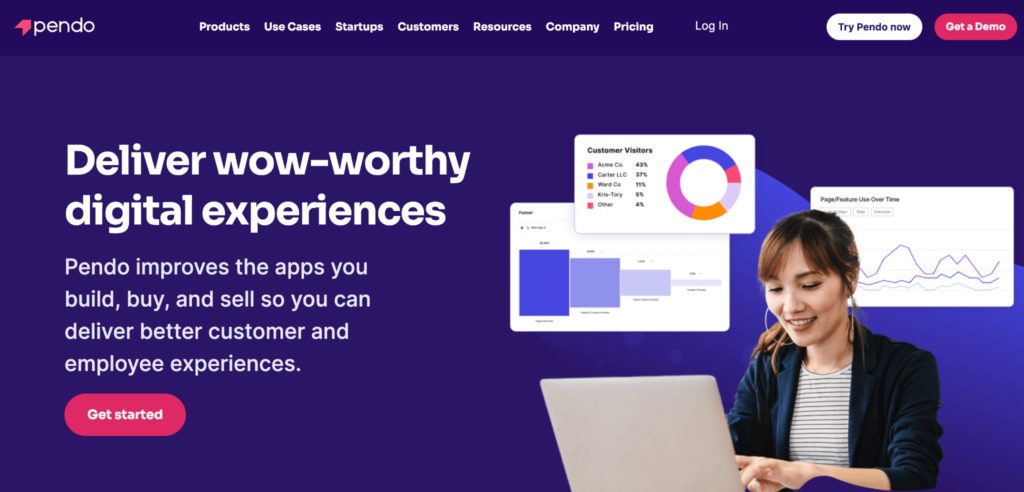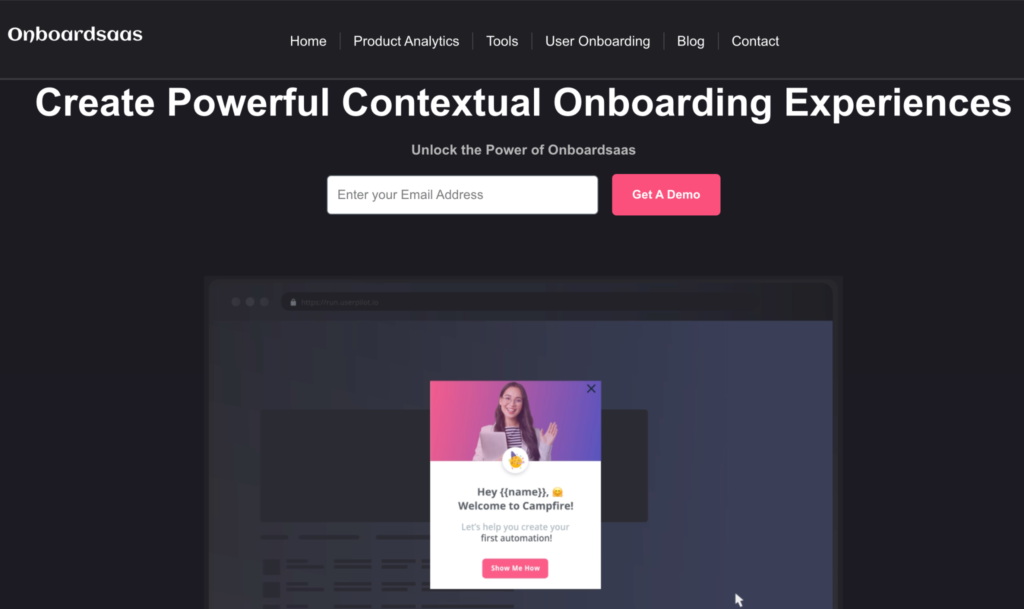The right software tool can make all the difference when enhancing the user onboarding process. One such tool that has been making waves is Pendo. But what exactly is pendo meaning, what does it cost, and its benefits and drawbacks?
In this in-depth look, we’ll demystify Pendo, providing you with all the information you need to determine if this tool fits your needs. 🚀🔍 Buckle up and dive in as we explore the world of Pendo. 💡
What is Pendo meaning?

Pendo is a product experience platform designed to help businesses understand and influence how their users interact with their software products. The name ‘Pendo,’ derived from the Latin word for ‘value,’ reflects the platform’s core aim – to provide value by creating seamless, meaningful interactions between businesses and their users. 💡🤝✨
Here’s an overview of Pando’s core functionalities:
- User Insights: Pendo allows businesses to track user behavior within their software products. It involves monitoring which features are used most often and identifying any elements that may be causing user frustration or confusion.
- Guided User Onboarding: Using Pendo, businesses can create interactive walkthroughs to guide new users through their software. It often includes tooltips, banners, and other in-app messaging to facilitate user comprehension and engagement.
- Feature Adoption: Pendo helps businesses encourage user adoption of new or underused features by highlighting them effectively within the software.
- User Feedback: Pendo includes tools for gathering user feedback, allowing businesses to make data-driven decisions and prioritize product development based on user needs and experiences.
Pendo is a comprehensive tool that helps businesses enhance their software’s user experience, improving user satisfaction and product success. 🚀💯
Top 5 Features of Pendo

The top-notch features that make Pendo stand out are: ✨💪🚀
- User Behavior Analytics: Pendo offers robust analytics that dive deep into how users interact with your product. It tracks every click, swipes, and interaction, providing valuable insights into user behavior patterns. For instance, you can see the most popular and rarely used features. It can help you optimize your product based on real user data.
- In-App Messaging: This feature allows businesses to communicate directly with their users within the product interface. You can create custom messages to guide users through complex features, announce new updates, or ask for feedback. For example, if you’ve just launched a new feature, you can set up a pop-up message to inform users about it and guide them on how to use it.
- NPS Surveys: Pendo includes the ability to send out Net Promoter Score (NPS) surveys. This tool helps businesses measure user satisfaction and loyalty. For instance, after a user has been using your product for a month, you could send them an NPS survey to gauge their satisfaction.
- Segmentation: With Pendo, you can segregate your users based on their behavior, geography, subscription level, and more. This feature can be incredibly useful for delivering personalized experiences. For example, you could create a specific onboarding experience for users in a particular industry or those using a specific feature frequently.
- Retention Analysis: Pendo provides tools to analyze user retention over time. It can help you identify where users drop off and what you can do to improve retention. For example, a significant drop-off after the initial onboarding might signal that your onboarding process needs to be improved.
These key features make Pendo an excellent tool for enhancing user experience and boosting product adoption. 🚀💡 It’s a comprehensive platform that offers a wealth of data and functionality to help businesses make informed decisions and continually improve their products based on user feedback and behavior. 📊🔍
Pendo Pricing: Explained

Pendo’s pricing structure is thoughtfully designed, offering solutions for businesses of varying sizes and needs. 🏢💼 It operates on a tiered pricing model, but note that specific cost details are not publicly available on its website.
Instead, Pendo prefers to provide customized pricing based on the specific requirements of each business. Here’s a general overview of their pricing tiers: 💰💻
- Free Trial: Pendo offers a free trial that enables businesses to test the platform before committing. This trial provides access to all core features and is a great way to determine if Pendo’s offerings align with your business’s needs.
- Essential Package: The Essential package is Pendo’s entry-level offering, ideal for startups or smaller businesses. It includes basic features like user insights and in-app messaging. Pricing for this tier would depend on the number of users and specific features needed.
- Professional Package: This tier offers more advanced functionalities for medium-sized enterprises. It includes everything in the Essential package and extra features like advanced analytics and segmentation.
- Enterprise Package: The Enterprise package is Pendo’s premium offering, ideal for larger businesses and corporations. This tier includes all the features Pendo offers, including robust analytics, personalized in-app messaging, and premium support.
It’s important to reach out to Pendo directly for a quote, as your final price will depend on the size of your user base and the specific features that best suit your business needs.
Remember, investing in Pendo is not just about the cost; it’s about the value it can bring to your user experience and, ultimately, your bottom line.
To put it in perspective, consider the potential return on investment (ROI). If Pendo’s analytics can help you retain just a few more customers each month or its onboarding guides can decrease customer service costs, the platform may quickly pay for itself.
Always weigh the cost against the potential benefits to make an informed decision.
How Pendo helps in better user onboarding

A smooth onboarding process is pivotal to user retention and satisfaction, and Pendo has multiple features that significantly aid in streamlining this process.
Guided Tours: One of the most compelling ways Pendo supports user onboarding is through its ‘Guided Tours’ feature. These interactive tutorials within the software guide new users step-by-step through their initial interactions with the product.
For instance, if you’re running a project management tool, you could create a guided tour that navigates users through setting up their first project, adding team members, or managing tasks. It offers users hands-on experience and reduces the learning curve, promoting confidence and proficiency in product use.
Contextual Help: Pendo’s ability to deliver contextual help is another powerful feature. It means you can create tooltips, lightboxes, or banners that appear when a user hovers over or clicks on specific elements of your product.
For example, a tooltip explaining how to use a complex feature could appear if a user hovers over a complex feature. This ‘in-the-moment’ help can be essential in reducing user frustration and improving product acceptance.
In-App Messaging: Pendo allows businesses to interact directly with their users within the application. In-app messages can be used to announce new features, offer tips and tricks, or assist during onboarding.
For example, a well-timed in-app message could encourage users to explore a feature they haven’t tried before, improving their overall product understanding and engagement.
Personalized Onboarding: Pendo enables businesses to create personalized onboarding experiences through its robust segmentation capabilities. For instance, if a segment of users sign up for a specific use case, the onboarding process can be tailored to highlight the features that would be most useful to them. This personalized approach can significantly enhance user experience, helping them see the value in the product right from the start.
Feedback Mechanisms: Lastly, Pendo offers effective methods for collecting user feedback during onboarding. Through NPS surveys and other feedback tools, businesses can identify pain points, frustrations, and areas of confusion. This feedback is invaluable for iterating and improving the onboarding process over time.
Pendo’s nuanced and diverse features provide businesses with a wealth of resources to facilitate an intuitive and seamless user onboarding process, leading to increased user adoption and product success. 🚀💼🎉
9 PROS AND CONS OF Pendo

Just like any other tool, Pendo has its own set of strengths and weaknesses. Understanding these is fundamental to making an informed decision regarding its usage. 💪🔍
Pros of Pendo
- User Behavior Analytics: Pendo’s robust analytics provide deep insights into user behavior. It allows product managers to understand how users engage with their product, which features they use the most, and where they abandon the product.
- Feature Adoption: Through in-app messaging and guided tours, Pendo helps drive feature adoption. It can be particularly beneficial when launching new features or functionality.
- User Segmentation: Pendo’s advanced segmentation capabilities help businesses deliver targeted, personalized experiences. Companies can segment users by behavior, location, subscription level, etc.
- NPS Surveys: Pendo’s in-built NPS survey feature is a valuable tool for gauging user satisfaction and loyalty, providing critical insights that can help drive product improvements.
- Improved Onboarding: Pendo’s guided tours and contextual help features can greatly improve onboarding, reducing user frustration and accelerating product adoption.
Cons of Pendo
- Learning Curve: Pendo’s wide array of features can be overwhelming and require a learning curve to fully understand and leverage.
- Cost: Pendo can be expensive, especially for small businesses or startups. The significant investment may not be justifiable for companies with a tight budget.
- Limited Customization: While Pendo offers a range of customization options, there might be constraints on how much the in-app messages and guides can be tailored to match the look and feel of the product.
- Reliance on Technical Support: Setting up and troubleshooting Pendo may often require assistance from their technical support team, which can sometimes be time-consuming.
Considering these pros and cons, it’s clear that while Pendo offers numerous benefits ✅, its complexities and costs may pose challenges ❗. Therefore, businesses must evaluate their specific needs and resources before integrating Pendo into their product strategy. 💼💡
Top 7 ALTERNMATIVES of pendo
- Intercom: Intercom is a popular customer communication platform that offers live chat, product tours, and customer engagement tools. It allows businesses to send users targeted in-app messages and emails, effectively guiding them through the onboarding process.
- WalkMe: Known for its interactive guidance system, WalkMe is another robust alternative to Pendo. With its ‘Walk-Thru’ tool, businesses can easily create step-by-step guides that help users navigate complex software applications.
- UserIQ: UserIQ combines user intelligence, targeted engagements, and customer health scoring to deliver a personalized user experience. Its guided tours, in-app messages, and analytics make it a powerful tool for improving user onboarding and retention.
- Appcues: Appcues takes a visual approach to user onboarding, allowing businesses to create attractive onboarding flows without writing a single line of code. Its feature set includes user segmentation, in-app messaging, and NPS surveys.
- Userlane: Userlane offers interactive guides and automated onboarding experiences to help users understand new software quickly. It’s a particularly useful tool for SaaS companies that want to simplify the onboarding process for their users.
- Gainsight PX: Gainsight PX is a product experience platform providing deep user behavior insights. It also offers in-app engagements and feedback surveys, making it a comprehensive tool for improving product adoption.
- Whatfix: Whatfix is an all-in-one Digital Adoption Platform that assists businesses in creating interactive walkthroughs, personalized content, and task automation. It’s a great solution for reducing user confusion and increasing adoption rates.

Each alternative offers a unique approach to user onboarding and engagement, making them worthy contenders to Pendo. Depending on a company’s specific needs and budget, one of these alternatives may be more suitable. 🤔💼💡
ONBOARDSAAS: The best Pendo Alternative

Regarding user onboarding and customer engagement, OnboardSaaS stands out as an impressive alternative to Pendo. Here are the key reasons why this platform has gained significant recognition and is considered the best Pendo alternative: 💯🚀✨
- User Friendly: Unlike Pendo, which has a steep learning curve, OnboardSaaS.com is created with user-friendly interfaces that are easy to navigate. It reduces the time and resources required to familiarize with the platform, making it an efficient choice for businesses of all sizes.
- Cost-Effective: The pricing structure of OnboardSaaS.com is much more accessible, especially for startups and small to medium-sized enterprises. It delivers robust features without causing a strain on the budget, providing excellent value for money.
- Highly Customizable: OnboardSaaS.com offers a higher degree of customization than Pendo. It allows businesses to tailor onboarding processes and in-app messages to match their brand identity and specific needs, enhancing the user experience.
- Excellent Support: The platform is known for its prompt and efficient technical support. Users have praised the responsiveness and expertise of the support team, which reduces downtime and ensures smooth operations.
- Comprehensive Analytics: OnboardSaaS.com provides insightful analytics that helps businesses understand user behavior, track feature adoption, and gauge user satisfaction. These insights facilitate data-driven decision-making, ultimately enhancing the product’s success.
OnboardSaaS, with its user-friendly design ✨, affordability 💰, customization capabilities 🎨, efficient support 🙌, and comprehensive analytics 📊, is a strong contender for the best Pendo alternative. Its features are designed to deliver a seamless and effective user onboarding experience, supporting businesses in their journey towards increased user adoption and overall product success. 🚀
Conclusion
Pendo is a powerful user onboarding and engagement platform offering many features and benefits. However, its complexity, cost, and limited customization may not suit all businesses.
Therefore, exploring alternative options like Intercom, WalkMe, UserIQ, Appcues, Userlane, Gainsight PX, or Whatfix can help businesses find a better fit for their needs and resources.
In particular, OnboardSaaS.com stands out as an excellent alternative to Pendo, providing a user-friendly, customizable, cost-effective, and comprehensive solution for seamless onboarding and customer engagement. 🌟
Ultimately, it’s crucial for businesses to thoroughly evaluate their requirements before selecting any onboarding platform to ensure the best return on investment.
So, exploring alternatives and choosing the one that best aligns with their goals and objectives is always advisable.
With these top 7 alternatives, businesses can find a suitable solution that meets their unique needs, ultimately helping them drive user adoption, retention, and overall product success. 💪
So, if you’re looking for an efficient and effective solution for user onboarding and engagement, don’t limit yourself to Pendo. Explore these alternatives and find the one that works best for your business. Happy onboarding! 😊

10+ years experience in Marketing and Operations

